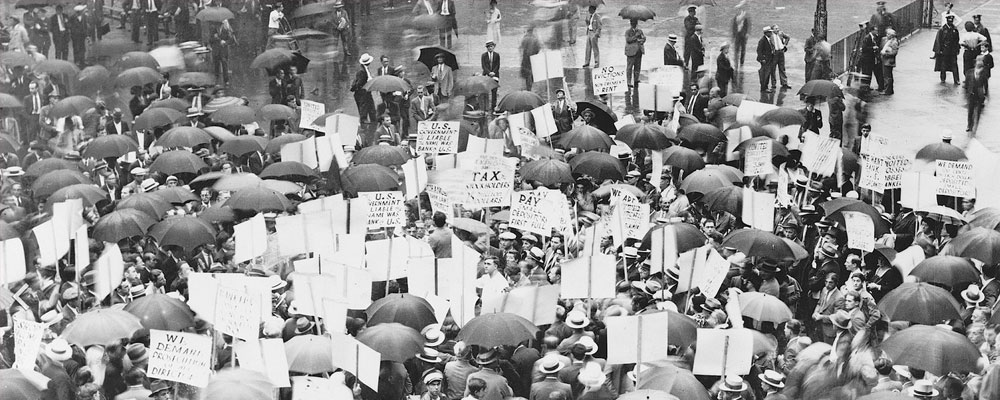
The financial crisis of 2008 has prompted many commentators to claim that we are about to enter another Great Depression. Yes, we are entering a serious slump— one that will probably last until late 2009 or early 2010. That said, the current slump is not (and will not be) comparable to the Great Depression of 1929-1933. Before they manufacture a greater crisis, the chattering classes should stop scaring the public and check the facts. Unlike the current crisis, the Great Depression was “great.” The money supply in the United States, measured by currency, plus demand deposits (M1), dropped by 25% (see Table 1). And not surprisingly, a sharp deflation occurred, with all major price indices registering significant declines (see Table 2).
National income in the United States was cut by more than half (53.5%). Unemployment rose from 3.1% in 1929 to 24.7% in 1933, with manufacturing accounting for the largest decline in employment—falling from 21.6% of the labor force in 1929 to 14.3% in 1933. Trade (exports, plus imports), as a portion of the gross national product, collapsed and didn’t regain its pre-Great Depression levels until the early 1970s. Economic prospects were so dismal in the U.S. that more people were emigrating than immigrating—a very abnormal occurrence.
One of the most significant features of the Great Depression was the collapse of private domestic investment. On a gross basis, it fell from 19.6% of GNP in 1929 to 4.4% in 1933—thanks, in part, to a dramatic drop in business inventories. By 1932, net private domestic investment was negative, indicating that the economy’s capital stock was shrinking.
Profits are the reward of the active capitalists—the entrepreneurs. In contrast, interest is the reward of the passive capitalists. The impact of inflation and deflation on the distribution of income to these two types of capitalists is noteworthy. Profits are derived from purchasing something at a particular time and selling it later at a higher price. When all prices are rising, this is relatively easy to do; when all prices are falling, it’s very difficult. Accordingly, deflation shifts income from profits to interest. The surge in the portion of national income going to “net interest” (from 5.6% in 1929 to 10.4% in 1933) and the decline in the portion going to profits (from 11.3% in 1929 to -3.8% in 1933) was as unsurprising as it was catastrophic (see Table 1).
The Great Depression was one of the most extraordinary episodes in U.S. economic history, if not the entire capitalist world. To compare the current crisis to the Great Depression is stretching the facts beyond the breaking point.
Table One
Money Supply and National Income by Type, 1929-1933 
Table Two
Price Indices, 1929-1933 
And that’s not all. The purveyors of Great Depression myths—such as this year’s Nobel laureate in Economics Paul Krugman—assert that the fiscal stimulus which accompanied World War II rescued the economy from the Great Depression. In fact, the Great Depression was followed by a spontaneous recovery, with the unemployment rate falling from 24.7% in 1933 to 14.2% in 1937. This recovery was interrupted by a sharp slump in 1938-1939. It was concentrated in the manufacturing sector and was associated with a decline in gross private domestic investment.
Even though a spontaneous recovery occurred before World War II, it is important to stress that scholarship by Robert Higgs, and other economic historians, shows that—contrary to legend—the New Deal held down the spontaneous recovery and contributed to the 1938-1939 slump. Indeed, Higgs’ evidence demonstrates that investment was depressed by New Deal initiatives because of regime uncertainty—”a pervasive uncertainty among investors about the security of their property rights in their capital and prospective returns.” (Robert Higgs, Depression, War and Cold War: Studies in Political Economy. New York: Oxford University Press, 2006, p.5). In short, investors were afraid to commit funds to new projects because they didn’t know what President Roosevelt and the New Dealers will do next.
This brings us to the Troubled Asset Relief Program (TARP). This $700 billion bailout program is, among other things, a bureaucratic nightmare that is as confused as it is confusing. Add to that Treasury Secretary Henry Paulson’s major shifts in the TARP’s direction, as well as the circus on Capitol Hill, and we have all the ingredients for a royal case of regime uncertainty. It shouldn’t be surprising, therefore, that each time Secretary Paulson makes a pronouncement or the Congress performs another act, the stock market takes a dive.
Author Steve H. Hanke

0 responses on "A Great Depression?"